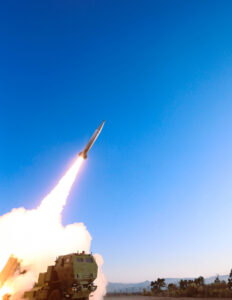Lockheed Martin [LMT] on Wednesday conducted its farthest test shot yet of the new Precision Strike Missile (PrSM), announcing the weapon “exceed[ed] maximum threshold” in its latest demonstration.
Both Lockheed Martin and the Army’s Long Range Precision Fires Cross Functional Team declined to specify the exact distance accomplished, while a company official told reporters a day ahead of the demonstration that the maximum range test shot was intended to reach a range of 499 kilometers.

“The Precision Strike Missile continues to validate range and performance requirements. Achieving this long-range milestone for the baseline missile demonstrates PrSM’s capability to meet our customer’s modernization priorities on a rapid timeline,” Paula Hartley, Lockheed Martin’s vice president of tactical missiles, said in a statement.
The maximum range test shot, conducted at Vandenberg Space Force Base in California, is the fifth PrSM flight test so far and will be followed by the first side-by-side missile firing during a test next month as part of the Army’s Project Convergence.
Lockheed Martin reiterated that the “maximum threshold” ahead of the test was 400 kilometers, which was the previous longest distance achieved during a demonstration at White Sands Missile Range in New Mexico in May (Defense Daily, May 12).
PrSM is the Army’s program to replace its legacy ATACMS missiles, also built by Lockheed Martin, with service officials noting the base weapon could be asked to reach ranges out past 500 kilometers, while subsequent technology spirals may push to ranges of 700 to 800 kilometers.
Wednesday’s flight test follows the Army’s approval to move the program into the Engineering and Manufacturing Development (EMD) phase and the award for the set of early operational capability missiles in September (Defense Daily, Oct. 1).
“This will make sure we can service the Army’s 2023 target fielding date to the warfighter. The EMD award moved the program to the next phase of development and will include system qualification and manufacturing readiness activities, which will culminate in a fully-qualified system. EMD will also include production qualification testing, flight and ground tests,” Hartley told reporters during a Tuesday briefing at the Association of the United States Army Conference (Defense Daily, Oct. 12).